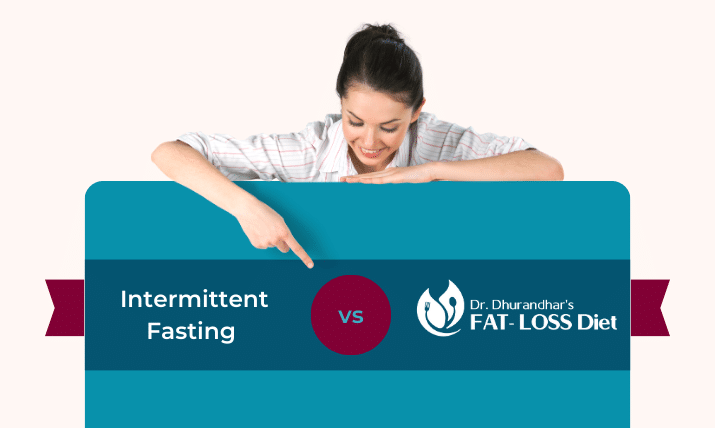Weight loss is a common goal for many people, and there are countless diets and methods available to help achieve this. Today, we will compare two popular approaches: Dr. Nikhil Dhurandhar’s Fat Loss Diet and Intermittent Fasting. We will discuss the principles, benefits, and potential drawbacks of each approach to help you decide which method might be best for you.
Scientific studies of both approaches have demonstrated that they are both effective ways to achieve fat-loss, on average. So the question is not which one produces more fat-loss, but which one is a better fit for you? There are big differences in the experience of each approach that will likely make one approach a much better fit.
Dr. Dhurandhar’s Fat Loss Diet
Dr. Nikhil Dhurandhar, a renowned nutritionist and obesity researcher, developed the Fat Loss Diet to help people lose weight in a healthy and sustainable way. The diet is based on the principle “Energy Balance,” which states that weight loss occurs when the body burns more calories than it consumes. Over 12 weeks, people can except to lose about 5% of their starting weight during the program. But it also is informed by decades of clinical studies that inform what makes the simplest, healthiest, and most comfortable way to endure a lower calorie intake.
Principles of Dr. Dhurandhar’s Fat Loss Diet
- Daily Calorie Control: The diet focuses on creating a calorie deficit by consuming fewer calories than your body needs to maintain its current weight. A diet plan helps achieve this, and individualized fat-loss recipes are given for portion controlled meals throughout the day.
- Macronutrient Balance: The diet emphasizes the importance of a balanced intake of carbohydrates, proteins, and fats. Dr. Dhurandhar recommends a macronutrient ratio of 50-60% carbohydrates, 20-30% proteins, and 20% fats for optimal weight loss. This balance promotes the retention of muscle mass during weight loss, and it also promotes energy levels and feeling full and satisfied throughout the day.
- Food Quality: The Fat Loss Diet encourages the consumption of foods that are rich in nutrients. This includes fruits, vegetables, whole grains, legumes and beans, lean proteins, and healthy fats.
Benefits of the Fat Loss Diet
- Sustainable Weight Loss: By focusing nutrient-rich foods and filling macronutrient ratios, the Fat Loss Diet promotes gradual and sustainable weight loss, which is more likely to be maintained in the long term.
- Improved Health: The diet encourages the consumption of nutrient-dense foods. This can lead to improved nutrient status, better overall health and a reduced risk of chronic diseases.
- Improved Metabolic Health: Studies have shown that 5% weight loss can improve insulin sensitivity, reduce inflammation, and lower the risk of chronic diseases such as type 2 diabetes and heart disease.
- No Food Restrictions: Unlike many other diets, the Fat Loss Diet does not require you to eliminate any food groups. They even show you how to consume sugar in healthy amounts. This makes it easier to follow and maintain over time.
Drawbacks of the Fat Loss Diet
- Requires Commitment: A diet plan is the main way the fat-loss nutrition is achieved, so one much commit to the diet plan as-written during the fat-loss phase.
- May Be Difficult for Some: For individuals who travel frequently or do not have a lot of control over what they eat, following the diet plan may be practically difficult. It may be difficult also for those with eating disorders.
Intermittent Fasting
Intermittent fasting (IF) is an eating pattern that cycles between periods of fasting and eating. It does not specify which foods to eat but rather when to eat them. There are several different IF methods, but the most popular ones are the 16/8 method (fasting for 16 hours and eating during an 8-hour window) and the 5:2 method (eating normally for five days and restricting calorie intake to 500-600 calories for two non-consecutive days).
Principles of Intermittent Fasting
1. Time-Restricted Eating: IF focuses on limiting the time window during which you consume calories. This can help create a calorie deficit, leading to weight loss.
2. Hormonal Regulation: Fasting periods can help regulate hormones related to weight loss, such as insulin. Lower insulin levels can facilitate fat burning. However, this effect also occurs with continuous energy restriction diets such as Dr. Dhurandhar’s Fat Loss Diet.
3. Cellular Repair: Some animal studies suggest that fasting may stimulate a process called autophagy, which is the body’s way of cleaning out damaged cells and generating new, healthy ones. However, other studies find that reducing calorie intake through other methods (like Dr. Dhurandhar’s Fat Loss Diet) can also upregulate autophagy.
Benefits of Intermittent Fasting
- Simplicity: IF is relatively easy to follow and does not require calorie counting or strict food restrictions.
- Improved Metabolic Health: Studies have shown that IF can improve insulin sensitivity, reduce inflammation, and lower the risk of chronic diseases such as type 2 diabetes and heart disease.
Drawbacks of Intermittent Fasting
- Hunger and Irritability: Fasting periods can lead to feelings of hunger and irritability, which may be difficult for some individuals to manage.
- Low energy levels: During fasting periods, low energy levels can impact your ability to work and keep up with family responsibilities.
- Potential for Overeating or eating poorly: Some people may overeat during their eating window, negating the calorie deficit created during fasting periods. There may also be no improvement in food quality and overall nutrition status.
- Not Suitable for Everyone: IF may not be appropriate for individuals with certain medical conditions, pregnant or breastfeeding women, or those with a history of disordered eating.
Conclusion
Both Dr. Dhurandhar’s Fat Loss Diet and Intermittent Fasting can be effective weight loss strategies, depending on individual preferences and lifestyles. The Fat Loss Diet focuses on calorie control, macronutrient balance, and food quality, promoting sustainable weight loss and improved overall health. Intermittent Fasting emphasizes time-restricted eating, offering a simpler approach to weight loss. It also may improve markers of aging and inflammation, but those effects may be related to weight loss in general and not specific to fasting.
Ultimately, the best weight loss method is the one you can stick to in the long term. It is essential to consult with a healthcare professional before starting any new diet or weight loss plan to ensure it is appropriate for your individual needs and goals.



